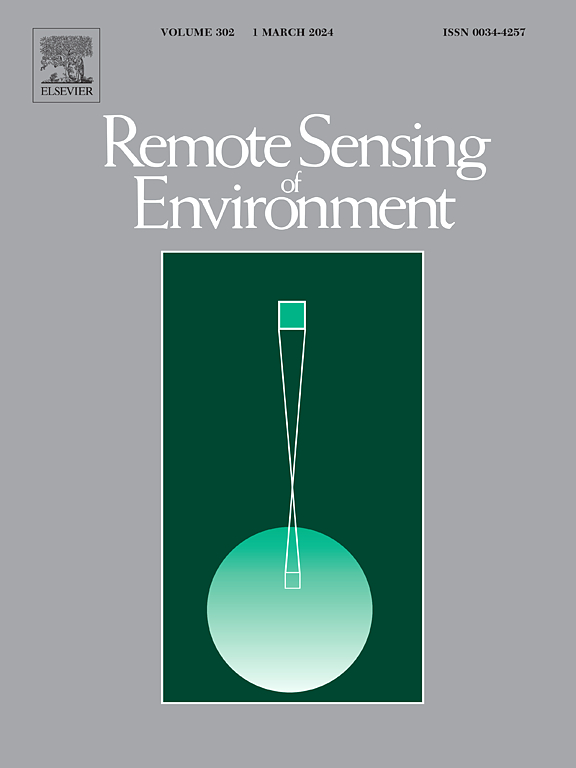Downscaling the full-spectrum solar-induced fluorescence emission signal of a mixed crop canopy to the photosystem level using the hybrid approach
IF 11.1
1区 地球科学
Q1 ENVIRONMENTAL SCIENCES
引用次数: 0
Abstract
Remote sensing of hyperspectral vegetation reflectance and solar-induced chlorophyll fluorescence (SIF) is essential for evaluating crop functionality and photosynthetic performance. While primarily applied in monocultures, these tools show promise in diverse cropping systems, enhancing ecological intensification. Plant-plant interactions in such systems can influence key physiological processes, such as photosynthesis, making SIF a valuable tool for evaluating how crop diversity affects photosynthetic function and productivity. However, detecting SIF in diverse stands remains challenging due to uncertainties in light re-absorption and scattering. To address these challenges, we propose a hybrid model inversion framework that combines canopy observations with physical modeling to derive leaf biochemical, canopy structural variables, and SIF spectra at leaf and photosystem levels. This approach employs a machine learning retrieval algorithm (MLRA), trained on synthetic spectra from radiative transfer model (RTM) simulations, to quantify re-absorption and scattering effects. Using the SpecFit retrieval algorithm, the temporal evolution of full-spectrum SIF at the canopy level can be derived. To downscale SIF to the photosystem level and retrieve its quantum yield, we corrected the canopy SIF spectrum for re-absorption and scattering effects calculated from TOC reflectance. Spectral measurements were gathered from field experiments conducted over three years, covering various growth stages of cereal and legume monocrops and their mixture. Our method accurately predicts important leaf biochemical and canopy structural variables, such as leaf area (LAI, R2 = 0.75) and leaf chlorophyll content (LCC, R2 = 0.91), and shows a general high retrieval performance for light absorption (fAPARChl, R2 = 0.99 for the internal model validation). We confirmed the reliability of our method in modeling re-absorption and scattering processes by comparing canopy SIF downscaled to the leaf level with independent leaf-level SIF measurements. While the results show a good prediction accuracy in terms of fluorescence magnitude at the leaf level, we did not find a strong agreement of corresponding leaf and canopy measurements at the single plot level.
利用杂交方法将混合作物冠层的全光谱太阳诱导荧光发射信号降阶至光系统水平
高光谱植被反射率和太阳诱导的叶绿素荧光(SIF)遥感对评估作物功能和光合性能至关重要。虽然这些工具主要应用于单一栽培,但在多种种植制度中显示出希望,加强了生态集约化。在这样的系统中,植物间的相互作用可以影响关键的生理过程,如光合作用,使SIF成为评估作物多样性如何影响光合功能和生产力的有价值的工具。然而,由于光的再吸收和散射的不确定性,在不同林分中检测SIF仍然具有挑战性。为了解决这些挑战,我们提出了一个混合模型反演框架,该框架将冠层观测与物理建模相结合,以获得叶片生化、冠层结构变量以及叶片和光系统水平的SIF光谱。该方法采用机器学习检索算法(MLRA),对辐射转移模型(RTM)模拟的合成光谱进行训练,以量化再吸收和散射效应。利用SpecFit检索算法,可以推导出冠层水平全谱SIF的时间演化。为了将SIF降至光系统水平并获取其量子产率,我们根据TOC反射率计算的再吸收和散射效应对冠层SIF光谱进行了校正。光谱测量是在为期三年的田间试验中收集的,试验涵盖了谷类和豆类单一作物及其混合物的各个生长阶段。该方法能够准确预测叶面积(LAI, R2 = 0.75)和叶绿素含量(LCC, R2 = 0.91)等重要的叶片生化和冠层结构变量,并具有较高的光吸收反演性能(内部模型验证的fAPARChl, R2 = 0.99)。我们通过比较缩小到叶片水平的冠层SIF和独立的叶片水平SIF测量值,证实了我们的方法在模拟再吸收和散射过程中的可靠性。虽然结果显示在叶片水平的荧光强度方面具有良好的预测精度,但在单个地块水平上,我们没有发现相应的叶片和冠层测量结果具有很强的一致性。
本文章由计算机程序翻译,如有差异,请以英文原文为准。
求助全文
约1分钟内获得全文
求助全文
来源期刊

Remote Sensing of Environment
环境科学-成像科学与照相技术
CiteScore
25.10
自引率
8.90%
发文量
455
审稿时长
53 days
期刊介绍:
Remote Sensing of Environment (RSE) serves the Earth observation community by disseminating results on the theory, science, applications, and technology that contribute to advancing the field of remote sensing. With a thoroughly interdisciplinary approach, RSE encompasses terrestrial, oceanic, and atmospheric sensing.
The journal emphasizes biophysical and quantitative approaches to remote sensing at local to global scales, covering a diverse range of applications and techniques.
RSE serves as a vital platform for the exchange of knowledge and advancements in the dynamic field of remote sensing.
 求助内容:
求助内容: 应助结果提醒方式:
应助结果提醒方式:


